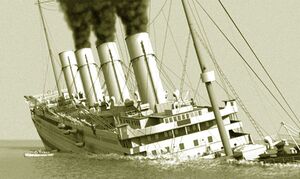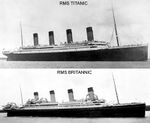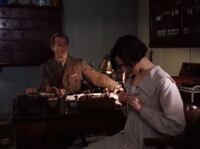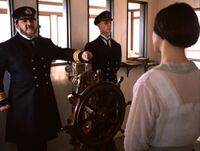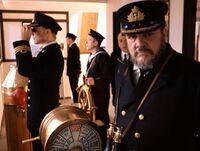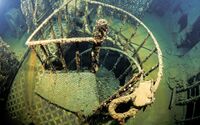HMHS Britannic
“Women and bedsteads first!”
“I am becoming a pro at this ship sinking business”
HMHS Britannic lies today at the bottom of the Mediterranean Sea. With the right diving equipment (a mini submarine will do), you can visit her today. You won't find any gold, luggage or a safe containing nude drawings of Kate Winslet lying on the seabed. Instead, your likely haul will be empty medicine bottles, damp bandages and rusty camp beds.
Britannic sank in World War One when her hull struck a German mine off the Greek Island of Kea in 1916. Built as a luxury liner to partner the White Star cruise ships RMS Olympic and RMS Titanic, the Britannic was instead enlisted to support the British war effort. Though her hull had allegedly been improved to bounce off passing icebergs, she wasn't designed to absorb the shock of setting off a mine. The Britannic was essentially a 'coffin ship', apt as passengers on the day she went down with her were wounded soldiers involved in the Gallipoli campaign.
Origins
The RMS Britannic was originally designed to be 'Queen of the Fleet', a ship that would have taken on board (literally) all the design changes and tweaks that her owners had first tried out on the Olympic and Titanic. Then Britannic was officially called the Gigantic, perhaps to have been followed later by new liners with the names Bombastic and Hyperbolic before the First World War intervened. By then the Gigantic had already been renamed the Britannic and now a patriotic paint job to show Britain was serious about fighting. Unfortunately no other substantial changes were made to the ship's structure. She was a floating tomb. A moronic non-decision had been made.
Design changes
The initial plan was to add guns and torpedo tubes to Britannic but this was ruled out as her size and bulk would have made her an easy target. White Star's rival Cunard had made a secret agreement with the government to convert their liners into auxiliary cruisers if war came. This was shown to be a mad idea when the RMS Lusitania sank like a stone in 1915 when she was discovered off the Irish coast by a U-Boat. Instead the Britannic was painted a brilliant gloss white with giant red crosses painted on her side and on the decks so that any passing Zeppelin would use her as a target practice. Plans to paint a cross on the ship's belly as an extra warning to U-Boats was not carried out as plan. However, considering she was sunk by dumb mine, it wouldn't have mattered.
Mine meld
The Britannic came into hospital service in December 1915. The enormous vessel had been stripped of anything fancy. It was a Spartan experience for anyone on board. The main decks of the ship consisted of long rows of rickety camp beds with a potty underneath. These beds were allocated to the injured soldiers. Higher ranks got their own cabins. On a separate level were the doctors and nurses. One woman in particular caught enough attention from others on the ship. She was Violet Jessop, a former stewardess on both the Olympic and Titanic. Jessop was regarded by some as a 'bad omen', something she dismissed until she kicked a box of black kittens overboard.
On 21st November 1916 the Britannic was in Greek waters, not far from that nice restaurant in Athens we found on our last holiday. It was a relatively warm morning for that time of year and the portholes had been opened to let the air circulate and the screams of the wounded and damage be dispersed upon the water. Captain Josiah Bartlett was in command of the ship. He had spent many long years on the North Atlantic routes and since the sinking of the Titanic, had been obsessed with German submarines disguised as iceberg. Bartlett had his crew on iceberg watch which is why the missed a recently deposited mine floating around the island of Kea in the Aegean Sea.
'BOOM!!'
- Captain Bartlett: We've hit an iceberg!
- First Officer: I think it is a mine Captain.
- Captain Bartlett: No that was definitely an iceberg. Can you see it??
- First Officer: I think respectively, you're wrong.
- First Engineer: She's doomed! We're taking in sea water in all compartments!!
- Captain Bartlett: No..no, she can't sink. Steer for the nearest beach!
- First Mate: Shall we send up flares?
- First Officer: Yes, they're terrible trousers. I prefer bell-bottoms.
- Captain Bartlett: First Class Passengers evacuate now. Gentlemen, take out your revolvers.
- Ship's cat: Rescue me if you want to stay lucky punk!
Britannic tried to make it towards the beach but in the panic, no one closed the portholes. Water gushed in and soon filled up the decks. Frantically, the ship's crew and hospital staff lowered the lifeboats or jumped into the sea (at least that was an improvement on the Titanic experience, the Mediterranean in December was mild). The Britannic lost steam and like a spider about to disappear down a plug hole, the ship circled around a whirlpool with her bow now filling up fast. The cry of abandon ship was heard and those who could, jumped or limped in.
Casualties
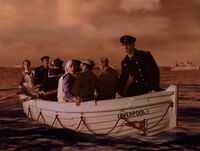
The ship was only about a third full when it sank. Considering most the 'passengers' were patients who were literally bed-bound, it's remarkable only 30 people died when Britannic said goodbye to the sky. Violet Jessop survived again. Like a cork she could always float. Captain Bartlett was also rescued but never given command of anything bigger than a tug boat after this. The Germans got the blame for their 'barbarism' for dropping mines in front of hospital ships. They in return said the British ship was carrying arms, the beds were actually dissembled artillery pieces and the crutches upside down rifles. Since the ship had sunk so deep, no one could check.
Aftermath
The Britannic was barely mentioned after the First World War. Its story wasn't as dramatic as the Titanic so no one made a movie about the sinking until 2000 and then they decided to sex it up with German spies/saboteurs blowing it up instead of an inert mine or suspicious iceberg. The film was a flop.
The Britannic remains rusting away, on the bottom of the sea and in better shape than any of her sister ships. Perhaps she will be re-floated one day.
